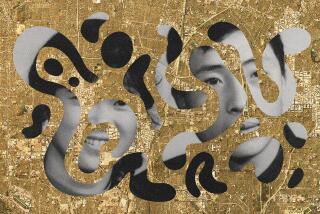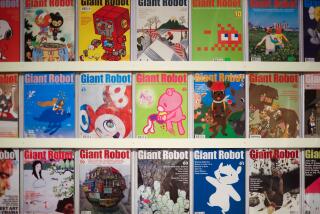Exhibit Traces a Century of Traditions and Trials : Museum: Displays focused on Southern California reveal the difficult path Japanese American women have followed in this country.
Many of the first Japanese American women came to the United States as âpicture brides,â kimonoed women brave enough or desperate enough to spend a month at sea traveling to marry men whose faces they knew only from photographs.
Their daughters--the generation known in Japanese as nisei--thought of themselves as citizens like any other. But when the Japanese bombed Pearl Harbor, thousands of Japanese American citizens found themselves robbed of their possessions and shipped off to harsh detention camps because of the color of their skin.
The third generation, called sansei, includes women such as Kristi Yamaguchi, who won a skating gold medal for the United States at the Albertville Olympics in 1992. More than 50% of sansei marry non-Japanese men.
âStrength & Diversity: Japanese American Women 1885-1990â is the subject of an award-winning exhibit running through May 30 at the Gene Autry Western Heritage Museum in Griffith Park.
Based on interviews with 50 Japanese American women, the show was originally organized by the National Japanese American Historical Society and the Oakland Museum, where it opened in 1990.
In part because Japanese American soldiers, many fresh from the camps, fought so heroically during World War II, the story of Japanese American men has been told before. But as Rosalyn Tonai, one of the showâs Bay Area organizers, points out, this is the first exhibit that tells the story of Japanese American women, often in their own words.
*
What distinguishes this show from other ethnic exhibits, even groundbreaking ones, is that, as it travels around the country, the show is customized to reflect the local experience. âIt was very different in Hawaii than it was in Portland, Ore.,â Tonai said. Southern California has the largest concentration of Japanese Americans in the country--more than 130,000 in Los Angeles County alone. Working with the Japanese American National Museum in Little Tokyo, the Autry has tapped this rich community resource to give the show a local spin.
According to Michael Duchemin, curator of history at the Autry, the traveling portion of the show includes photographs, text--much of it taken from oral histories--and dozens of objects that document the journey of Japanese American women from immigration to their varied roles in contemporary culture. The era of the picture bride, for instance, is vividly evoked by the kimono, the iko, or kimono rack, and the Japanese wicker suitcase that accompanied one hopeful woman across the Pacific. Local additions flesh out the show and allow visitors to see in detail how their Japanese American neighbors fared during almost a century of tradition, trial and change.
Before World War II, Japanese American women had even fewer job opportunities than Japanese American men. Many could get jobs only as domestic servants or at vegetable stands. But during the 1930s, some local women attended the Gardena Dressmaking College. The show includes a photo of the class of 1936, plus a diploma and a program for the ceremony that marked them as full-fledged seamstresses.
*
Inevitably, some of the most powerful material involves the notorious ârelocation centers.â As a result of the exclusion order of 1942, many Japanese Americans were, in the words of writer Eugene V. Rostow, âsent to concentration camps on a record which wouldnât support a conviction for stealing a dog.â Locally, many internees were held temporarily at the Santa Anita racetrack in Arcadia before being moved to internment camps. At Santa Anita, children did their school lessons in the grandstand in front of the parimutuel windows because their mothers did not want their education interrupted.
According to Tonai, whose mother was a teen-age internee in Rohwer, Ark., many people, however guiltless, were ashamed of being interned and never spoke about their camp experiences.
The exhibit includes such eloquent objects as an oil painting titled âFamily in Camp Room,â done in Rohwer. It shows how internees tried to brighten the small, barracks-like spaces where they suffered marriage-testing lack of privacy and other indignities.
The exhibit also bears witness to the achievements of contemporary women. In the exhibit is a robe worn by Fumiko Hachiya Wasserman as a Los Angeles Superior Court judge. âIt brings the story up to the present,â Duchemin said.
*
âStrength & Diversity: Japanese American Women 1885-1990â through May 30 at the Gene Autry Western Heritage Museum, 4700 Western Heritage Way, next to the Los Angeles Zoo. Open daily except Monday, 10 a.m. to 5 p.m. Admission is $7 for adults, $5 for senior citizens and students with valid ID and $3 for children 2 through 12. Information: (213) 667-2000. For a list of related activities at the Japanese American National Museum, 369 East 1st St., call (213) 625-0414.
More to Read
Sign up for Essential California
The most important California stories and recommendations in your inbox every morning.
You may occasionally receive promotional content from the Los Angeles Times.










